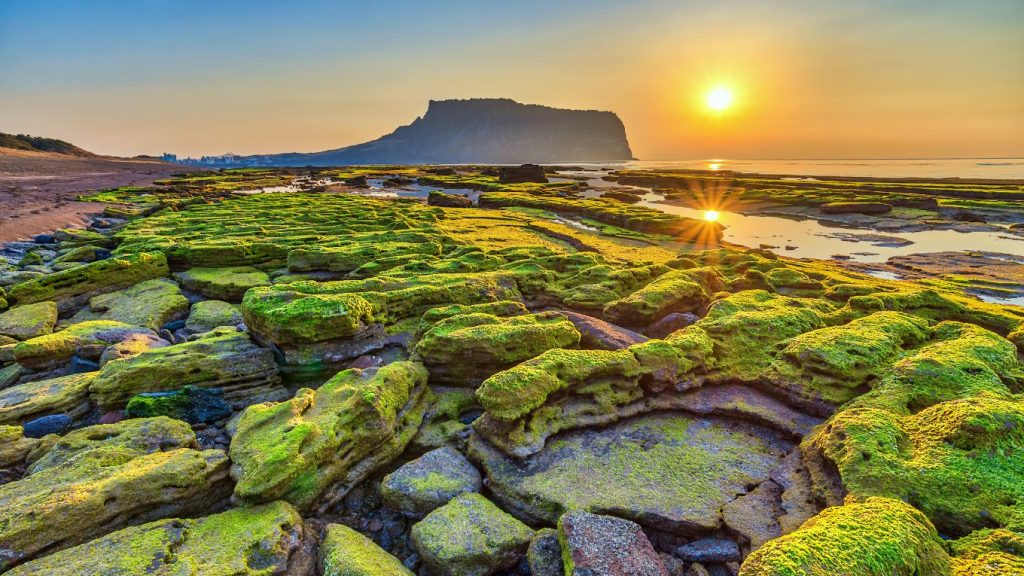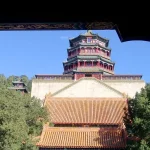Jeju Island is no stranger to Korean drama fans or anyone passionate about exploring the land of kimchi. Unlike the bustling, fast-paced vibes of Seoul or Busan, Jeju offers a peaceful retreat with a touch of untouched wilderness. If it’s your first time traveling to Jeju on your own, you’re bound to feel a bit overwhelmed. Hopefully, the tips in this article will make your journey smoother and more enjoyable.
Jeju Island: 3 Essential Tips to Know Before You Depart
Introduction to Jeju, the Paradise Island
Jeju Island came into existence over two million years ago due to volcanic eruptions. This unique history and geological makeup earned it a spot as a UNESCO World Natural Heritage site in 2007. As South Korea’s largest island, it spans 1,848 square kilometers but has a relatively sparse population of about 600,000 people.
Lying at the southern tip of South Korea, Jeju is blessed with a mild climate. Winters here are warmer than in other regions, rarely dipping below 0°C, while summers are pleasantly cool, peaking at around 32–33°C. Jeju experiences all four seasons, though winter (December to February) and summer (June to August) stand out the most. Depending on your preferences, here are two approaches to planning your trip:
- For those who love great weather: Visit in late spring to early summer (April to June) or during the golden and red foliage season (September to October).
- For budget travelers: Steer clear of summer, as it’s Jeju’s peak season with a flood of local tourists. Also, in cherry blossom countries like Japan and South Korea, late March to April can get pricey as services “heat up” alongside demand.
How to Travel from Vietnam to Jeju Island
Jeju International Airport sits on the northern side of the island, about 3 kilometers west of Jeju City’s center. It’s a decent airport with average facilities, offering free Wi-Fi. Duty-free shopping, dining options, a kids’ play area, and gates for domestic and international flights are all on the third floor. The airport has two lounges: Asiana Lounge and KAL Lounge.
1. A Few Notes on Booking Flights
Visa-Free Entry to Jeju? Technically, Jeju allows visa-free entry, but due to complications with some Vietnamese travelers entering illegally, this policy isn’t fully applied to Vietnamese citizens. It’s best to secure a South Korean visa before heading to Korea in general, including Jeju.
- Jeju operates in the GMT+9 time zone, two hours ahead of Vietnam.
- Book your trip 2–3 months in advance. Traveling to Jeju during the off-season can snag you cheaper fares from airline promotions.
- Use Skyscanner to compare prices across airlines and seasons.
- Visa Details: As South Korea’s only autonomous province, Jeju has a unique open-door policy, allowing visa-free travel for many nationalities, including Vietnam. However, since there are no direct flights from Vietnam to Jeju, this exemption mainly applies to those on tours organized by four companies approved by the Korean Embassy. If you transit through Incheon Airport (Seoul), you’ll need to switch to Gimpo Airport for the next leg, requiring a Korean visa anyway.
Here are two flight options from Hanoi or Ho Chi Minh City to Jeju for you to consider!
2. Flying from Vietnam to Jeju (One Stop: Seoul or Busan)
Airlines:
- Leg 1: Hanoi/Ho Chi Minh City to Seoul or Busan
- Budget Airlines: Vietjet Air (seats are narrow, so it might feel tiring), T’way Air (more spacious than Vietjet).
- Premium Airlines: Vietnam Airlines, Korean Air, Asiana Airlines (Asiana offers the shortest flight at 3 hours and 55 minutes).
- Leg 2: Domestic Flight from Seoul (Gimpo Airport) or Busan (Gimhae Airport) to Jeju
- Budget Airlines: Jin Air (Air Seoul), Jeju Air, T’way Air (free cancellations within 60 hours of booking).
Notes:
- Fares range from 9–13 million VND (~360–520 USD). Domestic flights in Korea are affordable, starting at 1,100,000 VND (~44 USD) round-trip if booked early in the low season. I managed Vietjet + T’way for about 5,500,000 VND (~220 USD) for all four legs.
- Travel Time: Hanoi to Seoul takes ~4 hours; Seoul to Jeju takes ~1 hour.
- You’ll still need a Korean visa and must reclaim your luggage to check in again. With this option, I’d recommend adding Seoul or Busan to your itinerary to make the visa worthwhile.
3. Flying from Vietnam via a Third Country to Jeju
Here are three clever ways to visit Jeju without a Korean visa:
- Cathay Pacific: Vietnam – transit in Hong Kong – Jeju (from 500 USD). Super expensive!
- Bangkok Route: Vietnam to Bangkok, then Bangkok to Jeju with Eastar Jet. Long layovers due to limited flight schedules.
- Kuala Lumpur Route: Vietnam to Kuala Lumpur, then KL to Jeju with Air Asia X (route launched in 2017, a subsidiary of Air Asia). At Jeju Airport, just fill out an entry form and answer a few questions from staff.
Jeju Travel Tips
It’s no surprise that Jeju captivates visitors, earning its reputation as a top destination for both locals and international travelers. Three times the size of Seoul, the island is dotted with countless attractions—some wildly pristine, others steeped in cultural charm. I felt dizzy researching Jeju’s travel map before my trip; to truly experience it, you’d need 5–6 days.
To help you plan efficiently, I’ll suggest key spots split between the eastern and western sides of the island.
1. Exploring Eastern Jeju
Suggested Itinerary: Horseback riding → Seongeup Folk Village → Lunch → Seongsan Ilchulbong Volcano → Women Diver Show → Manjang Cave.
Horseback Riding: This was my favorite Jeju activity—I’d never ridden a horse before! Book at least a day ahead for around 450,000 VND (~18 USD) per adult. The ride lasts 10–15 minutes with an English-speaking guide.
Seongeup Folk Village: Dive into Jeju’s unique culture, from traditional thatched-roof homes to local beliefs, lifestyles, and cuisine. Entry is free.
Seongsan Ilchulbong Volcano: Formed by lava eruptions from the ocean floor hundreds of thousands of years ago, this volcano has a crater shaped like a bowl, ringed by 99 jagged rocks. It’s a fantastic spot to take in eastern Jeju’s scenery. Visit in the afternoon for convenience, or wake early to hike its 100+ steps and watch the sunrise with a warm cup of tea.
2. Western Jeju
Mount Hallasan: For outdoor enthusiasts, this majestic mountain at Jeju’s center is a must. With seven trails ranging from 1.3 km to 10 km, pick one based on your fitness and time. Hiking is free, but start times are regulated to ensure you’re not descending too late. Pair a long trail with one nearby attraction for a fulfilling day.
Loveland Park: Just 10 minutes from Jeju Airport, this 18+ spot is a hit with couples. It features 140 nude statues in various intimate poses. Entry costs 9,000 won (~7 USD), and touching the exhibits is allowed!
Cheonjihyeon Waterfall: Locals take pride in this natural masterpiece. Wander the forest trail around the falls for a refreshing adventure. I’ve heard that in May of even-numbered years, the lake opens for swimming during the Seven Fairies Festival—give it a try if you’re there!
Jungmun Beach: Skipping Jeju’s beaches in summer would be a shame. The island’s top three beaches, including Jungmun, lie in the south and attract surfing pros.
Must-Try Foods on Jeju Island
For me, half the joy of travel is tasting local flavors. Don’t miss these iconic Jeju dishes:
- Black Pork: Jeju’s black pork is juicy and tender, whether grilled or boiled.
- Sashimi: With its abundant fresh seafood, Jeju’s sashimi is a must. In winter, try yellowtail—a large, tuna-like fish with rich, fatty meat.
- Abalone Porridge: This nutritious dish boasts a delicate flavor. In Jeju, it’s cooked with whole rice grains, unlike Vietnam’s smoother version.
- Omegi Tteok: A special rice cake made from millet and sticky rice, filled with red bean paste and coated with whole red beans. It’s mildly sweet, nutty, and perfect as a snack or gift.
Tips for Booking Hotels in Jeju
Jeju offers a wide range of accommodations—hotels, resorts, guesthouses—so your choice depends on your purpose, itinerary, and budget.
1. Where to Stay on Jeju?
Two main areas stand out:
- Jeju-si: The island’s main city, close to the airport, buzzing with eateries and shopping. Less lively than Korea’s big cities, it’s ideal for nightlife lovers. Stay near Tapdong shopping street or the market to save on transport.
- Seogwipo-si: In the south, this area is packed with attractions, perfect for a 2-night stay. It’s quieter than Jeju-si but still has plenty of dining and a night market.
Transportation Tips for Self-Guided Jeju Travel
Getting around Jeju requires careful planning. Here are three options: renting a car, taking the bus, or using a taxi.
1. Renting a Car in Jeju
For groups, renting a car is the smartest choice.
Pros:
- Flexibility and time-saving. Jeju’s attractions are scattered across the island, often far apart.
- Cost-effective. Prices start at 1,800,000 VND (~72 USD) per day for a 4-seater KIA, including fuel and insurance.
Notes:
- Convert your Vietnamese driver’s license to an International Driving Permit (valid for 1 year).
- After landing, head to Gate 5 for a free shuttle to the rental office. Pay, complete paperwork, and pick up your car after a staff check.
2. Buses
Pros:
- Low cost.
Notes:
- With Jeju’s sparse population, public transport isn’t highly developed. Buses are inconvenient, with inconsistent schedules and stops far from attractions, meaning more waiting and walking.
- Use a T-money card for payment—top it up if you’re also visiting other Korean cities.
- Key routes: 600 and 755 from the airport; 600, 701, and 702 cover most major sights.
3. Taxis
Two types: short-trip taxis and private taxis for longer routes.
Pros:
- Time-saving. Drivers know the roads and can suggest great eateries or sights.
Notes:
- Expensive but suits larger groups. Private taxis charge 150,000–200,000 won (~120–160 USD) for 8 hours/day based on your itinerary. English-speaking drivers cost more.
Jeju is the kind of place you’ll want to revisit time and again to soak in all its wonders. I hope these insights make your self-guided trip to Jeju Island a breeze. Feel free to ask any questions below—I’d love to help!











